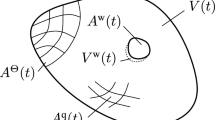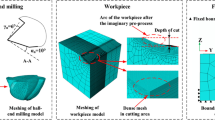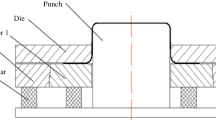Abstract
Deep drawing is an extensively used press working process since it eliminates expensive machining and welding operations and enables the production of components at a very high rate. The workpiece material used in a deep drawing process is anisotropic in nature, due to a prior thermomechanical treatment. Earing is one of the major defects observed in a deep drawing process due to the anisotropic nature of the sheet material. Knowledge about the ear formation in deep drawing allows a prior modification of the process, which can result in a defect-free final product with financial savings. In this paper, a recently proposed anisotropic yield criteria by Barlat et al. for rolled sheets is used to model the anisotropy for simulating the earing defect in square and circular cup drawing processes. The effect of the tooling geometry and process parameters on the ear formation is studied. It is shown that, in the square cup, the uneven metal flow rate, rather than the material anisotropy, is mainly responsible for the flange earing. Finite element formulation, based on the updated Lagrangian approach, is employed for the analysis. The stresses are updated in a material frame and the logarithmic strain measure is used, which allows the use of a large increment size. Isotropic hardening is assumed, and it follows a power law. Inertia forces are neglected due to small accelerations. The modified Newton–Raphson iterative technique is used to solve the nonlinear incremental equations.
Similar content being viewed by others
References
Lange K (1985) Handbook of metal forming. McGraw-Hill, New York
Schuler G (1998) Metal forming handbook. Springer, Berlin
Hill R (1948) A theory of the yielding and plastic flow of anisotropic metals. Proc R Soc Lond 193:281–297
Woodthorpe J, Pearce R (1970) The anomalous behaviour of aluminium sheet under balanced biaxial tension. Int J Mech Sci 12(4):341–347
Hill R (1979) Theoretical plasticity of textured aggregates. Math Proc Camb Philos Soc 85:179–191
Gotoh M (1977) A theory of plastic anisotropy based on a yield function of fourth order (plane stress state)—I. Int J Mech Sci 19:505–512
Gotoh M (1977) A theory of plastic anisotropy based on a yield function of fourth order (plane stress state)—II. Int J Mech Sci 19:513–520
Ferron G, Makkouk R, Morreale J (1994) A parametric description of orthotropic plasticity in metal sheets. Int J Plast 10(5):431–449
Barlat F, Chung K, Richmond O (1993) Strain rate potential for metals and its application to minimum plastic work path calculations. Int J Plast 9(1):51–63
Barlat F, Aretz H, Yoon JW, Karabin ME, Brem JC, Dick RE (2005) Linear transformation-based anisotropic yield functions. Int J Plast 21:1009–1039
Barlat F, Lian J (1989) Plastic behavior and stretchability of sheet metals, part-I: a yield function for orthotropic sheet under plane stress conditions. Int J Plast 5(1):51–66
Hosford WF (1972) A generalized isotropic yield function. Trans ASME J Appl Mech 39:607–609
Barlat F, Lege DJ, Brem JC (1991) A six-component yield function for anisotropic materials. Int J Plast 7:693–712
Karafillis AP, Boyce MC (1993) A general anisotropic yield criterion using bounds and a transformation weighting tensor. J Mech Phys Solids 41:1859–1886
Barlat F, Brem JC, Yoon JW, Chung K, Dick RE, Lege DJ, Pourboghrat F, Choi SH, Chu E (2003) Plane stress yield function for aluminum alloy sheets-part 1: theory. Int J Plast 19:1297–1319
Bron F, Besson J (2004) A yield function for anisotropic materials; application to aluminum alloys. Int J Plast 20:937–963
Yang DY, Kim YJ (1986) A rigid-plastic finite-element formulation for the analysis of general deformation of planar anisotropic sheet metals and its applications. Int J Mech Sci 28(12):825–840
Kawka M, Makinouchi A (1996) Plastic anisotropy in FEM analysis using degenerated solid element. J Mater Process Tech 60:239–242
Gotoh M (1980) A finite element analysis of the rigid-plastic deformation of the flange in a deep-drawing process based on a fourth-degree yield function-II. Int J Mech Sci 22:367–377
Moreira LP, Ferron G, Ferran G (2000) Experimental and numerical analysis of the cup drawing test for orthotropic metal sheets. J Mater Process Tech 108:78–86
Fromentin S, Martiny M, Ferron G, Tourki Z, Moreira LP, Ferran G (2001) Finite element simulations of sheet-metal forming processes for planar-anisotropic materials. Int J Mech Sci 43:1833–1852
Yoon JW, Song IS, Yang DY, Chung K, Barlat F (1995) Finite element method for sheet forming based on an anisotropic strain-rate potential and the convected coordinate system. Int J Mech Sci 37(7):733–752
Chung K, Shah K (1992) Finite element simulation of sheet metal forming for planar anisotropic metals. Int J Plast 8(4):453–476
Hu P, Liu YQ, Wang JC (2001) Numerical study of the flange earing of deep-drawing sheets with stronger anisotropy. Int J Mech Sci 43:279–296
Liu YQ, Wang JC, Hu P (2002) The numerical analysis of anisotropic sheet metals in deep-darwing processes. J Mater Process Tech 120:45–52
Nakamachi E (1995) Sheet forming process characterization by static-explicit anisotropic elastic–plastic finite element simulation. J Mater Process Tech 50:116–132
Yoon JW, Yang DY, Chung K (1999) Elastic-plastic finite element method based on incremental deformation theory and continuum based shell elements for planar anisotropic sheet materials. Comput Meth Appl Mech Engg 174:23–56
Yoon JW, Yang DY, Chung K, Barlat F (1999) A general elasto-plastic finite element formulation based on incremental deformation theory for planar anisotropy and its application to sheet metal forming. Int J Plast 15:35–67
Parente M, Valente RF, Jorge RN, Cardoso R, de Sousa RA (2006) Sheet metal forming simulation using EAS solid-shell finite elements. Finite Elem Anal Des 42:1137–1149
Cvitanić V, Vlak F, Lozina Z (2008) A finite element formulation based on non-associated plasticity for sheet metal forming. Int J Plast 24:646–687
Yoon JW, Barlat F, Chung K, Pourboghrat F, Yang DY (2000) Earing predictions based on asymmetric nonquadratic yield function. Int J Plast 16:1075–1104
Yoon JW, Barlat F, Dick RE, Chung K, Kang TJ (2004) Plane stress yield function for aluminum alloy sheets-part II: FE formulation and its implementation. Int J Plast 20:495–522
Yoon JW, Hong SH (2006) Modeling of aluminum alloy sheets based on new anisotropic yield functions. J Mater Process Tech 177:134–137
Yoon JW, Barlat F, Dick RE, Karabin ME (2006) Prediction of six or eight ears in a drawn cup based on a new anisotropic yield function. Int J Plast 22:174–193
Bathe KJ (1996) Finite element procedures. Prentice Hall of India, New Delhi
Varadhan SN (1997) Dynamic large deformation elasto-plastic analysis of continua. Master’s thesis, Mechanical Engineering Department, IIT Kanpur
Lange K, Herrmann M, Keck P, Wilhelm M (1991) Application of an elasto-plastic finite element code to the simulation of metal forming processes. J Mater Process Tech 27:239–261
Hu JG, Jonas JJ, Ishikawa T (1998) FEM simulation of the forming of textured aluminum sheets. Mater Sci Eng 256:51–59
Yoon JW, Barlat F, Gracio JJ, Rauch E (2005) Anisotropic strain hardening behavior in simple shear for cube textured aluminum alloy sheets. Int J Plast 21(12):2426–2447
Soare S, Yoon JW, Cazacu O (2008) On the use of homogeneous polynomials to develop anisotropic yield functions with applications to sheet forming. Int J Plast 24(6):915–944
Author information
Authors and Affiliations
Corresponding author
Rights and permissions
About this article
Cite this article
Saxena, R.K., Dixit, P.M. Finite element simulation of earing defect in deep drawing. Int J Adv Manuf Technol 45, 219–233 (2009). https://doi.org/10.1007/s00170-009-1963-5
Received:
Accepted:
Published:
Issue Date:
DOI: https://doi.org/10.1007/s00170-009-1963-5




